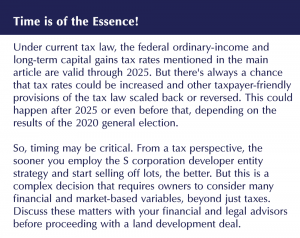In many places, real estate prices are soaring. That’s good news for owners of undeveloped land in those areas. But if they decide to subdivide and develop highly appreciated property, it could trigger a whopping income tax bill.
Fortunately, there’s a way to reduce the tax hit: Set up an S corporation to develop and sell off the lots. Here’s how this strategy works.
High Tax Rates for Real Estate Dealers
The Internal Revenue Code generally treats a land developer as a real estate “dealer.” A dealer’s profit from developing and selling land is considered profit from selling inventory. That means the entire profit—including the portion from any predevelopment appreciation in the value of the land—is taxed as ordinary income rather than as long-term capital gain.
For most individual taxpayers, ordinary-income tax rates are higher than long-term capital gains tax rates. The current maximum federal rate on an individual’s ordinary income is 37%. You may also owe the 3.8% net investment income tax (NIIT) for a combined maximum federal rate of 40.8% on ordinary gains for a real estate dealer. When you factor in state income tax, your combined tax rate on a large land sale profit could be 50% or higher.
You could save taxes if you could arrange to pay lower long-term capital gains tax rates on at least part of the profit. The current maximum federal rate on long-term capital gains is 20% (although many taxpayers owe 15%). If you also owe the 3.8% NIIT, your combined maximum federal rate would be 23.8%.
Important:
Today’s relatively low tax rates may not last. Consider developing highly appreciated property sooner rather than later to help reduce your tax hit. (See “Time Is of the Essence!” at the bottom.)
S Corporation Developer Strategy
By setting up an S corporation to develop the property, you can make yourself eligible for favorable long-term capital gains tax treatment for all the predevelopment appreciation in the value of your land. This strategy assumes that you’ve held the property for more than one year for investment, rather than as an established dealer in real estate.
Unfortunately, even with this strategy, any profit attributable to subdividing, developing and marketing activities will be taxed as ordinary income, not as long-term capital gain, because you will be treated as a dealer for that part of the profit. But if you can manage to pay an effective federal tax rate of 23.8% on a big chunk of your profit (the portion from predevelopment appreciation), that’s much better than paying an effective federal tax rate of 40.8% on it as a real estate dealer.
How Much Can You Save?
Consider the following example. Jane Doe owns a large parcel of land that she bought for $2 million in 2010. Its current fair market value is $5 million. So, the land’s predevelopment appreciation is $3 million.
Assuming Jane employs the S corporation developer entity strategy, $3 million of her profit would be taxed at a federal rate of no more than 23.8% (the 20% maximum federal rate on long-term capital gains + 3.8% for the NIIT) under current law. If she reaps $2 million of profit from development and marketing activities, that portion of the profit would be taxed at ordinary-income tax rates, which can be as high as 40.8% federally (the 37% maximum federal rate on ordinary income + 3.8% for the NIIT).
As a result, the maximum federal income tax hit under current law would be $1,530,000 [(23.8% × $3 million) + (40.8% × $2 million)]. Without using this strategy, the entire $5 million profit would likely be taxed at the maximum 40.8% ordinary-income rate, resulting in a federal tax hit of $2,040,000 (40.8% × $5 million).
3-Step Process
To put the S corporation developer entity strategy to work for your land development deal, follow these three steps:
1. Establish an S corporation. If you as an individual are the sole owner of the appreciated land, you can establish a new S corporation owned solely by you to function as the developer entity. If you own the land through a partnership or a limited liability company (LLC) treated as a partnership for tax purposes, you and the other owners can form the S corporation and receive corporate stock in proportion to your ownership interests.
2. Sell the land to the S corporation. The sale price is the land’s predevelopment fair market value. If necessary, you can arrange a sale that involves only a little cash and a big installment note owed by the S corporation to you (or to you and the other co-owners). The S corporation will pay off the note with cash generated by selling off parcels after development.
Under current tax law, the sale to the S corporation will trigger a long-term capital gain eligible for the 23.8% maximum federal rate under the current tax regime, if you’ve owned the land for more than one year and held it for investment purposes.
3. Use the S corporation to develop the land. The S corporation will subdivide and develop the property, market it and sell it. The profit from these activities will be ordinary income passed through to you (or to you and the other co-owners). The maximum federal tax rate on subdividing, development, marketing and selling activities could be as high as 40.8% under current law.
However, the average tax rate on the entire profit will be lower than 40.8%, because the predevelopment appreciation is taxed at a maximum federal rate of 23.8%.
Right for You?
The S corporation developer entity strategy can be a major tax-saver in the right circumstances. Contact us at 434.296.2156 for guidance.

© 2024 CPA Site Solutions.
Disclaimer of Liability
Our firm provides the information in this article for general guidance only, and does not constitute the provision of legal advice, tax advice, accounting services, investment advice or professional consulting of any kind. The information provided herein should not be used as a substitute for consultation with professional tax, accounting, legal or other competent advisors. Before making any decision or taking any action, you should consult a professional advisor who has been provided with all pertinent facts relevant to your particular situation. Tax articles in this blog are not intended to be used, and cannot be used by any taxpayer, for the purpose of avoiding accuracy-related penalties that may be imposed on the taxpayer. The information is provided “as is,” with no assurance or guarantee of completeness, accuracy or timeliness of the information, and without warranty of any kind, express or implied, including but not limited to warranties of performance, merchantability and fitness for a particular purpose.
Contact Us
Blog
Nonprofit Insights

